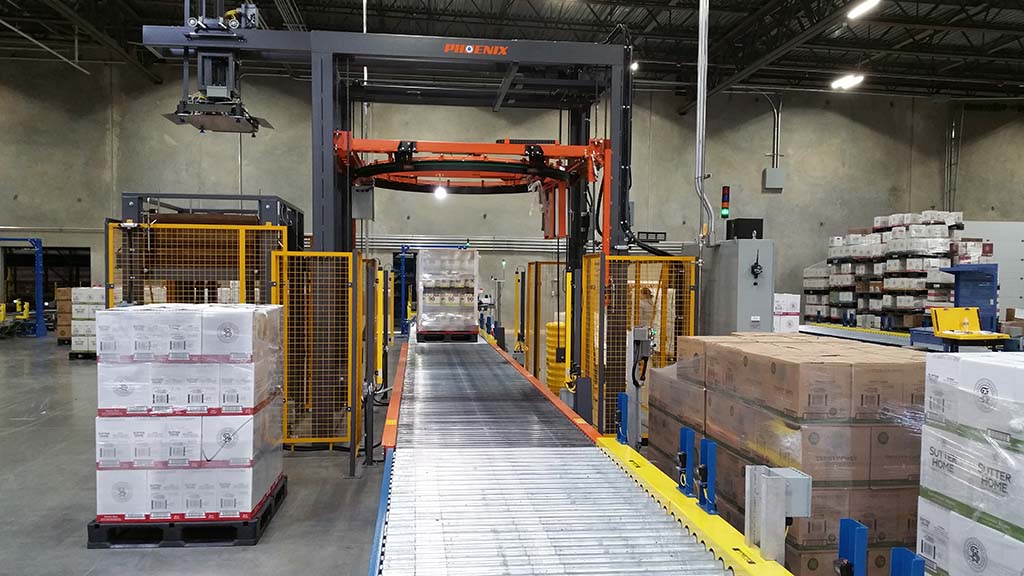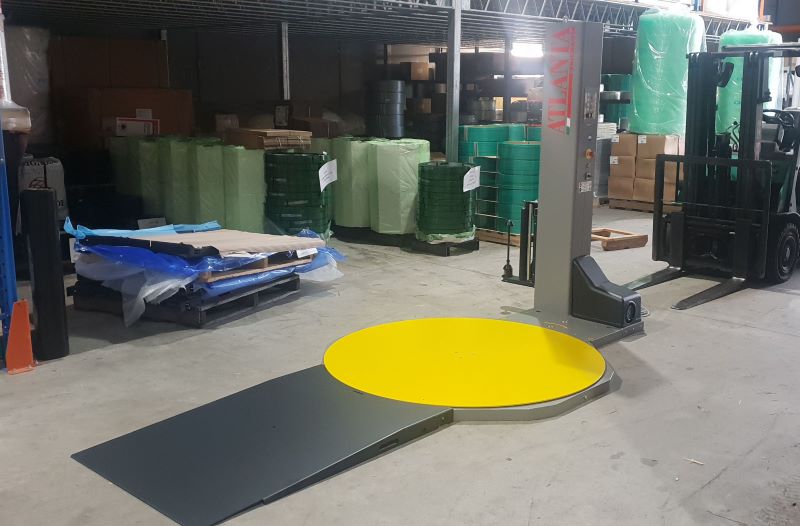
Pallet Wrap Machines: Benefits of Automated Packaging Processes
If you’re involved with any type of high-volume processing or manufacturing business, then you understand how difficult the logistics of moving large quantities of unfinished products through plants and warehouses, or shipping finished products safely out the door can be.
In fast-moving environments where boxed, bulk quantity, or like-sized items are routinely handled, palletized, and moved from one location to the next, stretch wrapping and binding are material handling precautions that make sense. If there are endless streams of these items though, routinely tasking employees with repetitively bending, pulling, and straining with hand dispensers all day isn’t just inefficient, it’s a situation that’s also rife for musculoskeletal injury.
Stretch wrapping is only one part of a larger problem, though. What your business really needs are more effective ways to combine and package goods that are safe for both materials as well as material handlers. Fortunately, there are machines designed to do just that, and one may be the capital investment that’s needed to get your throughput level to where it should be.
Contents
Sensible Automated Packaging Processes
With so many high-volume businesses relying on stretch wrapping, binding, and other types of bundling solutions throughout their production activities, automating these processes should be at the top of their resource planning. The truth, however, is that many businesses put it off because of the perceived cost. What they don’t realize though is just how much integrating an automatic pallet wrap machine and binding machine into their core packaging process will ultimately increase revenue. Automating the packaging process ensures that your products and personnel are protected. And with customer satisfaction based as much on the state and uniformity of your packaging as it is on the quality of your products, their confidence in receiving damage-free goods is invaluable.

The Basics and Benefits of Automation
Although key decision makers are aware of the importance of package and pallet wrapping, it’s easy to overlook the value that automating these processes can have. Both stretch wrapping and package binding allow, among other things:
· Products to be protected from damage, tapering, or theft;
· Total restriction from exposure to dirt, dust, or moisture;
· Easier, more accurate inventory taking;
· Easier movement and storage of products within facilities; and,
· Greater consolidation of products for transport or delivery.
Automating these processes with a stretch wrapping machine, strapping machine, or carton sealing machine takes these steps even further by:
· Increasing wrapping and packaging speeds;
· Decreasing the time intervals between various wrapping and sealing activities; and,
· Increasing the volume of products and materials that can be wrapped or packaged.
By integrating a pallet wrapping machine and other compatible equipment into the operation, measurable increases in performance and consistency throughout the logistics chain are possible. Automation boosts efficiency, and wherever there’s an increase in efficiency, there’s also an opportunity to realize cost savings.
The Costs of Not Automating
If a measurable increase in throughput is chartable with an automatic stretch wrapper or other packaging systems, it’s not surprising that until many businesses undertake a thorough process audit, do they fully recognize just how much of a cost disadvantage they’re continuing to operate at by not automating.
Manual Wrapping is Wasteful
Stretch wrapping film and binding strap are expensive consumables. Inconsistent variations in containment pressures and pallet heights, and a range of human factors such as fatigue and inattention can result in significant amounts of film being wasted every day if it’s not being applied uniformly, or being over-applied. With an automatic wrapping machine or binder, the amount of film or strap consumed, from the first pallet of a production run to the thousandth, will be precisely the same.
Packages or pallets that haven’t been sufficiently stabilized using a handheld stretch wrapper or manual binder are tip-over accidents waiting to happen. Typically false senses of security over pallet stabilities can result in higher rates of injury and product damage occurring during storage or transport than if the pallets hadn’t been secured at all. Automatic packaging systems are designed to secure every pallet and package exactly the way they need to be.

Manpower Isn’t Being Optimised
Manually wrapping, strapping and sealing packages and pallets can consume an almost incalculable amount of valuable man hours that are the equivalent of lost productivity. The more time that forklift operators, material handlers, and even production workers are forced to spend manually wrapping and strapping material, the less time they’re able to spend on more critical jobs.
Automatic pallet wrapping machines and packaging systems are solutions that can eliminate all of these workflow restrictions and more. But although saving costs on consumables and damages, and better manpower reutilisation are important, automation’s really about helping businesses protect their greatest asset: the health of their employees.
Safety as the Catalyst for Automation
As convenient as manually applying pallet wrapping plastic or using hand strap binding equipment may be for quick tasks, depending exclusively on securing pallets manually is simply too risky to be considered a long-term strategy. The musculoskeletal injuries employees can incur due to repetitive motion and even falling materials can be as severe as they are debilitating, with the cost to your business being:
· Lost production capacity due to employee absence;
· Lasting damage to employee satisfaction and morale;
· Employee compensation, healthcare, and disability costs;
· The possibility of fines or litigation attributable to a predictably unsafe environment; and,
· The potential for negative backlash from customers due to employee safety.
Automating the pallet wrapping and packaging functions instantly reduces the likelihood of serious workplace injuries, and the resultant legacy costs associated with them. And for businesses that fully understand the scope of what’s at stake, the decision to automate these activities is one that’s well worth committing to.
The Final Word
There’s no denying how much businesses depend on stretch wrap and binding straps for all kinds of moving, storing, and shipping. The challenge they face is finding the most effective and efficient ways to use their packaging resources, and ultimately do more with less.
Simply by investing in an automatic pallet wrap machine or binding machine, a high-volume business can expect to see immediate savings in the reduction of their packaging consumables, as well as an increase in throughput, and customers will immediately notice the quality commitment too.
If your business is considering how to improve its productivity while cutting its costs and liabilities, automating your packaging functions is the way to go.

